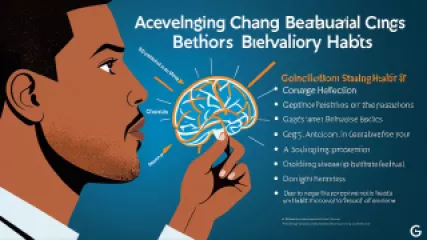A Step-by-Step Guide to Achieving Lasting Behavioral Change
A Step-by-Step Guide to Achieving Lasting Behavioral Change
Embarking on a journey of behavioral change can be both exciting and daunting. Whether you're striving to break a long-standing habit, adopt a healthier lifestyle, or cultivate a more positive mindset, the path to lasting transformation can seem arduous at times. However, with the right strategies and a steadfast commitment, you can overcome obstacles and unlock the profound benefits that come with sustainable behavioral shifts. In this comprehensive guide, we'll explore a step-by-step approach to achieving lasting behavioral change, empowering you to take control of your life and unlock your full potential.
Understanding the Foundations of Behavioral Change
Before we delve into the practical steps, it's essential to grasp the underlying principles that govern behavioral change. At the core of this process is the recognition that our behaviors are deeply rooted in our thoughts, emotions, and environmental factors. To effect lasting change, we must address these interconnected elements and develop a holistic understanding of the driving forces behind our current behaviors.
The Role of Cognitive-Behavioral Therapy
One of the most well-established frameworks for behavioral change is the principles of cognitive-behavioral therapy (CBT). CBT posits that our thoughts, feelings, and behaviors are inextricably linked, and that by addressing the cognitive distortions and unhelpful thought patterns that underlie our behaviors, we can facilitate meaningful and sustainable change.
Through CBT, individuals learn to identify the negative or irrational thought processes that fuel undesirable behaviors, and then develop strategies to challenge and replace these thought patterns with more constructive alternatives. This approach empowers individuals to take control of their thought processes, regulate their emotions, and ultimately, adopt new and more beneficial behaviors.
The Importance of Habit Formation
Another crucial element in the pursuit of lasting behavioral change is the concept of habit formation. Habits are the automatic behaviors and routines we engage in on a daily basis, often without conscious deliberation. By understanding the mechanism of habit formation and leveraging it to our advantage, we can successfully embed new, desirable behaviors into our lives.
The process of habit formation involves three key components: the cue, the routine, and the reward. By identifying the triggers that prompt our current behaviors, designing intentional routines to replace them, and associating those new routines with positive reinforcement, we can gradually wire our brains to adopt the desired behaviors as habits.
Laying the Groundwork for Behavioral Change
With a foundational understanding of the principles underlying behavioral change, let's delve into the practical steps you can take to embark on your transformation journey.
Step 1: Reflect on Your Current Behaviors
The first step in achieving lasting behavioral change is to take an honest and introspective look at your current behaviors. Identify the specific behaviors you wish to change, and explore the underlying reasons behind them. Ask yourself questions such as:
- What are the behaviors I want to change, and why are they important to me?
- What are the thoughts, emotions, and environmental factors that contribute to these behaviors?
- How do these behaviors impact my life, both positively and negatively?
- What are the potential benefits of changing these behaviors, and how will my life improve as a result?
By engaging in this self-reflection, you'll gain a deeper understanding of the roots of your current behaviors, which will inform the strategies you'll employ to effect change.
Step 2: Set Clear and Achievable Goals
With a clear understanding of your current behaviors, the next step is to set well-defined goals for the changes you wish to achieve. Effective goal-setting is crucial for maintaining motivation and tracking progress throughout your behavioral change journey.
When setting your goals, be sure to make them SMART: Specific, Measurable, Achievable, Relevant, and Time-bound. For example, instead of a vague goal like "eat healthier," a SMART goal might be: "To cook and consume a home-cooked, balanced meal at least five times per week by the end of the next three months."
It's important to strike a balance between ambitious yet realistic goals. Reaching for stretch goals can fuel your motivation, but setting overly lofty targets can lead to frustration and discouragement. Celebrate small victories along the way, and be willing to adjust your goals as needed to maintain a sense of progress and accomplishment.
Step 3: Identify Triggers and Barriers
Behavioral change does not occur in a vacuum; it's heavily influenced by both internal and external factors. To navigate your journey effectively, it's essential to identify the specific triggers and barriers that may hinder your progress.
Triggers are the cues, events, or situations that prompt your current, undesirable behaviors. These can range from emotional states (e.g., stress, boredom, or cravings) to environmental factors (e.g., the presence of certain people, locations, or temptations).
Barriers, on the other hand, are the obstacles that may impede your ability to adopt and sustain new behaviors. These can be practical constraints (e.g., lack of time or resources) or psychological impediments (e.g., fear, self-doubt, or lack of support).
By identifying and understanding these triggers and barriers, you can proactively develop strategies to mitigate their influence and create an environment that is conducive to your desired behavioral changes.
Implementing Strategies for Lasting Behavioral Change
With the foundational elements in place, it's time to delve into the specific strategies and techniques that will empower you to achieve lasting behavioral change.
Step 4: Develop a Personalized Action Plan
To translate your goals into tangible action, it's crucial to develop a personalized action plan that outlines the specific steps you'll take to facilitate your desired behavioral changes. This plan should address the following key components:
- Specific Behavioral Targets: Clearly define the behaviors you aim to change, and break them down into measurable, incremental steps.
- Coping Strategies: Identify the triggers and barriers you've uncovered, and devise strategies to manage or overcome them, such as developing alternative routines or seeking support.
- Accountability Measures: Establish mechanisms to hold yourself accountable, such as tracking progress, seeking accountability partners, or scheduling regular check-ins.
- Reward System: Incorporate a system of positive reinforcement to celebrate your successes and maintain motivation throughout the process.
By creating a detailed, personalized action plan, you'll provide yourself with a clear roadmap to navigate the ups and downs of your behavioral change journey.
Step 5: Cultivate Mindfulness and Self-Awareness
Achieving lasting behavioral change requires not only external strategies but also a deep level of internal self-awareness and mindfulness. By cultivating these qualities, you'll be better equipped to observe your thoughts, emotions, and behaviors with clarity, and make conscious choices that align with your desired outcomes.
Mindfulness practices, such as meditation, journaling, or even simply taking moments throughout the day to pause and reflect, can help you become more attuned to the present moment and the drivers behind your actions. This heightened self-awareness can enable you to catch negative thought patterns or impulses early, and respond to them with intention rather than reactivity.
Additionally, engaging in regular self-reflection, such as reviewing your progress, identifying areas for improvement, and celebrating your successes, can reinforce your commitment to change and provide valuable insights to refine your strategies moving forward.
Step 6: Embrace Flexibility and Adaptability
Behavioral change is a dynamic process, and it's important to approach it with a sense of flexibility and adaptability. Inevitably, you will encounter setbacks, unexpected challenges, or situations that require you to adjust your approach. Rather than viewing these as failures, embrace them as opportunities for growth and learning.
Be willing to experiment with different techniques, tweak your action plan as needed, and remain open to the possibility that your initial goals may need to be refined or adjusted along the way. The path to lasting change is rarely linear, and being able to navigate the twists and turns with resilience and agility will be key to your long-term success.
Step 7: Cultivate a Support Network
Embarking on a journey of behavioral change can be a deeply personal and introspective process, but it's essential to surround yourself with a supportive network that can bolster your efforts and provide encouragement along the way.
This support network may include trusted friends, family members, or even professional coaches or therapists who can offer guidance, hold you accountable, and celebrate your progress. Additionally, connecting with communities of individuals who are also striving for positive change can foster a sense of camaraderie, shared understanding, and mutual inspiration.
By leveraging the power of social support, you'll not only enhance your motivation and resilience but also gain valuable insights and perspectives that can further refine your approach to behavioral change.
Sustaining Behavioral Change Over the Long-Term
Achieving lasting behavioral change is not a one-time event but rather an ongoing process that requires continuous effort and adaptation. As you progress through your journey, it's essential to employ strategies that will help you maintain your newfound behaviors and prevent relapse.
Step 8: Integrate New Behaviors into Your Lifestyle
For behavioral change to truly stick, it must become seamlessly integrated into your daily life. This means finding ways to weave your new, desirable behaviors into your existing routines and environments, making them as effortless and habitual as possible.
One effective strategy is to identify opportunities to "stack" your new behaviors onto existing habits. For example, if you've set a goal to exercise more, you could commit to doing a short workout immediately after your morning coffee routine. By linking the new behavior to an existing habit, you'll increase the likelihood of it becoming a lasting part of your lifestyle.
Additionally, consider how you can reshape your physical and social environments to support your new behaviors. This might involve rearranging your living space, establishing new social circles, or incorporating reminders and cues that reinforce your desired actions.
Step 9: Celebrate Milestones and Maintain Motivation
Sustaining behavioral change over the long-term requires a continuous effort to maintain motivation and a sense of accomplishment. Celebrate your progress along the way, acknowledging both the small wins and the significant milestones.
This can be done through a variety of methods, such as tracking your progress, rewarding yourself with meaningful experiences, or sharing your successes with your support network. By regularly reflecting on how far you've come and the positive impacts your changes have made, you'll reinforce your commitment and stay energized for the journey ahead.
It's also important to be mindful of potential setbacks or relapses, and to view them as temporary obstacles rather than failures. When these occur, respond with self-compassion, analyze the factors that contributed to the setback, and swiftly re-engage with your action plan to regain momentum.
Step 10: Continuously Evolve and Refine
The final step in achieving lasting behavioral change is to approach the process with a mindset of continuous evolution and refinement. As you progress, your needs, priorities, and circumstances may change, requiring you to adapt your strategies and goals accordingly.
Regularly review your action plan, assess your progress, and be willing to make adjustments as needed. This may involve setting new goals, exploring alternative coping mechanisms, or seeking additional support to address emerging challenges.
By embracing a mindset of ongoing growth and adaptation, you'll ensure that your behavioral changes remain relevant, effective, and aligned with your evolving aspirations, ultimately leading to a more fulfilling and sustainable transformation.
Conclusion: Embrace the Journey of Behavioral Change
Embarking on a journey of behavioral change is a profound and empowering process that can unlock a world of personal growth, enhanced well-being, and greater alignment with your values and goals. By following the step-by-step guide outlined in this article, you'll be equipped with the knowledge, tools, and strategies to navigate this transformative journey with confidence and determination.
Remember, the path to lasting behavioral change is not always linear, and it's important to approach it with patience, self-compassion, and a willingness to adapt. Embrace the challenges, celebrate the victories, and trust in the power of your own resilience and commitment to change.
Ultimately, the rewards of achieving lasting behavioral change are immeasurable. As you cultivate new habits, shift your mindset, and unlock your full potential, you'll experience a profound sense of personal fulfillment, improved quality of life, and the confidence to tackle any obstacle that comes your way. Embark on this transformative journey today, and unlock the boundless possibilities that await you.






